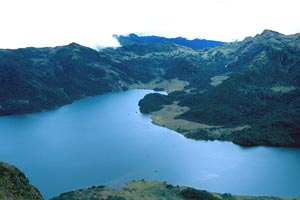 “Wayfarer, there is no path, you make the path as you go.”
“Wayfarer, there is no path, you make the path as you go.”
|
|
| English | Español | Deutsch | Français | Nederlands |
THE COUNTRY
- Why Ecuador?
- Slide Show
THE BOOK
- Foreword
- Preface
- Acknowledgments
- Table of Contents
- Trek Summaries
- Index
- About the Authors
- About the Publisher
A SAMPLE TREK
- Overview
- Route Description
- Topographic Map
- Elevation Profile
HOW TO BUY
THE BOOK
UPDATES
FEEDBACK
LINKS
CONTACT US
- The Authors
- The Publisher
© 2002-07 Kunstaetter
Overview
 |
|
Laguna Puruhanta as seen from Cerro Negro Rumi. (Photo: RK) |
Within Ecuador's system of protected natural areas, Cayambe-Coca Ecological Reserve is considered to have the greatest diversity of flora and fauna. It is an excellent place for bird-watching, with some 900 species of birds having been recorded here. Cayambe-Coca is a large reserve covering many life zones from the summit of Cayambe at 5790 meters (18,997 feet), down to Amazon rain forest. The reserve includes 81 different lakes, many of them wild and difficult to access.
This trek passes through the northwest of the Cayambe-Coca Reserve, a high area with beautiful glacial valleys, rugged peaks, and mostly undisturbed vegetation. The route goes from Laguna San Marcos north to Laguna Puruhanta, through some truly wild country. Both large lakes are popular fishing spots, with abundant trout, but few people venture far beyond the access points; you are likely to go for days without meeting another party. A shorter loop in the Laguna San Marcos area is also mentioned below.
This high páramo, with beautiful views of snow-capped Cayambe, is among the few places in Ecuador where you can see the Andean Condor. There are also hummingbirds, guans, Red-backed Hawks, and tanagers. Waterfowl include the Andean Duck, Andean Teal, and Andean Gull. This is likewise home to the Spectacled Bear, White-tailed deer, and Mountain Tapir. The vegetation is that of a wet páramo, similar to the Llanganates (see A Living Sponge in Trek 16). There are many highland ferns, mosses, and cushion plants, but also plants found in drier areas such as chuquiraguas and gentians. Along the lake shores and in the Río Pisque valley are rich cloud forests.
A project to provide irrigation for the flower growing valleys of Cayambe and Tabacundo is being built in the Laguna San Marcos area. As a result, the level of the lake might change. At the northern end of the park is a buffer zone with forests administered by local communities, including Nueva América. They are trying to encourage eco-tourism as a form of sustainable economic development. Here too, a waterworks project is under construction to divert water from the Río Palaucu for irrigation in the Pimampiro valley.
|
ESSENTIALS
Trekking Center: Otavalo.
Rating: Difficult 25-kilometer (15.5-mile), 5- to 6-day trek.
Elevation: 2900 to 3950 meters (9500 to 13,000 feet).
Maps: IGM 1:50,000: CT-OII-E1 Mariano Acosta, CT-OII-E3 Nevado Cayambe. IGM 1:25,000 (optional): CT-OII-E1c Laguna de Puruhanta, CT-OII-E3a Laguna San Marcos.
Best time to visit: October through February are drier, although you can get fog and rain at any time of the year. June, July, and especially August can be cold and windy.
Special gear: Fishing rod; machete or pruning shears.
Water: Available from streams along the way, tank up for the ridge portions.
Hazards: Navigation can be difficult in the fog and thick forest.
Annoyances: Mud.
Permits and Fees: The entrance fee for Cayambe-Coca Ecological Reserve is $10 for foreigners, payable at the ranger's station at the south end of Laguna San Marcos.
Services: Cayambe is the nearest town to the trailhead with hotels and restaurants. Local guides can be hired in the village of Olmedo (no accommodations here). Park rangers can sometimes guide you, Cayambe phone (02)236-1015 or (09)993-7367. They can likewise arrange for pack animals, but these go along an alternate route (the Filo de Ismuquiru ridge) and can only make it as far as Cerro Jatuncunga.
Toward the end of the route is the village of Nueva América with a house for visitors ($6 per person, meals available). If doing the walk in reverse, starting from the north, you can also get a guide and pack animals here. Animals make it only to the private house by the Río Palaucu, where you can also arrange to be picked up on your way out. Guides from Nueva América only know the route as far as Laguna Puruhanta. Several days advance notice are required for all services from Nueva América; call ahead to the Unidad de Medio Ambiente, Municipio de Pimampiro, phone (06)937-117 extension 16. There are no accommodations in Mariano Acosta. Pimampiro has one hotel and simple restaurants.
Provisions: Cayambe has well stocked shops. This town is famous for its string cheese and bizcochos (biscuits). Only very basic supplies are available in Olmedo and nothing at all in Nueva América. |
who helped prepare a preliminary version of this trek.
| Overview | Route Description |
| Topographic Map | Elevation Profile |


